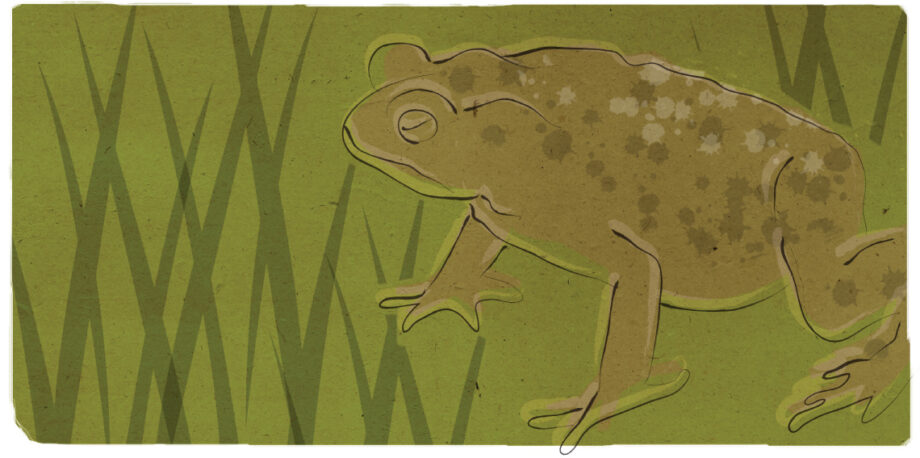February 5, 2014 — The enormous, warty and brown cane toad was introduced to Australia intentionally in 1935 as a form of natural pest control — it was supposed to eat native beetles that threatened the profitability of sugar plantations. Unfortunately, the toads never got a taste for beetles. They did, however, turn out to have a rambling bone. They’re also poisonous to predators. The result is a huge amphibian (adults can weigh as much as 4 pounds) that can travel as far as 25 miles in a year, leaving a trail of dead and injured animals — especially snakes — in its wake.
The story of the cane toad is a nightmare — a classic example of an ecologically devastating invasive species. In the short term, anyway. But the long term might be different. That’s because the toads don’t exist in a vacuum. They aren’t just something dropped on top of an existing environment, to be forever separate from it. Over time, even invasive species become part of the places they invade and the processes of life that happen there. In 2004, researchers from the University of Sydney, New South Wales, discovered that Australian snakes were changing in ways that made them able to successfully prey on invasive cane toads. Species with a lot of exposure to the toads in their habitat were trending toward smaller mouths — mouths that made them unable to eat the largest, most poisonous toads. Instead, those snakes ate smaller, less-poisonous, juvenile toads. And snakes aren’t the only predators adapting. Crows have been spotted picking up the toads, flipping them over, and eating the less poisonous flesh from their bellies.
While, theoretically, eradicating an invasive species ought to be cheaper than managing it or adapting to it, that’s not necessarily true if “eradication” is essentially a never-ending war.
The point isn’t that invasive species are awesome. They frequently do a lot of damage and they remain a prime example of humans’ ability to negatively impact the environment. But you can’t just think about the impact of invasives in terms of what you see them doing over the course of a couple of decades. There’s evidence that, given time, invasives can turn out to have a mixture of positive and negative effects, like any organism. What’s more, the native animals and plants with which they share a habitat can, and do, adapt to them, converting dysfunction into a part of a functional — albeit changed — system.
That’s important because, with the exception of invasions that were curtailed on small islands, we haven’t had much luck eradicating invasive species once they’ve gotten a toehold in a new world. Meanwhile, the financial costs mount. While, theoretically, eradicating an invasive species ought to be cheaper than managing it or adapting to it, that’s not necessarily true if “eradication” is essentially a never-ending war. The U.S. Department of Agriculture has been trying to eradicate the Mediterranean fruit fly in California since 1975, with hundreds of millions of dollars spent.
Simply being “native” or “invasive” isn’t enough to tell you whether a species should be eradicated.
At the same time, we have many examples of the relationship between invasives and their new home environments functioning in ways that might not warrant an automatic scorched-earth policy. Endangered southwestern willow flycatchers nest successfully in invasive tamarisk plants. Invasive trees in Puerto Rico do a better job of establishing forest on heavily degraded former pastures than do native trees, and provide a framework where the native plants can, eventually, take hold. Invasive birds help spread the seeds of native plants around the Hawaiian islands.
The ability of environments to adapt and the ability of invasives to be beneficial as well as harmful have led a handful of scientists to begin speaking out about the possibility of handling invasive species in a different way. Instead of jumping immediately to eradication, they suggest, the ideal course of treatment should, at least, begin with a more thorough examination of the full range of impacts each invasive species has on its new home. Simply being “native” or “invasive” isn’t enough to tell you whether a species should be eradicated.
As biologist Mark Davis wrote in a 2011 commentary in the journal Nature, “Nearly two centuries on from the introduction of the concept of nativeness, it’s time for conservationists to focus much more on the functions of species, and much less on where they originated.” ![]()
Editor’s note: The views expressed here are those of the author and not necessarily of Ensia. We present them to further discussion around important topics. We encourage you to respond with a comment below, following our commenting guidelines, which can be found here. In addition, you might consider submitting a Voices piece of your own. See Ensia’s “Contact” page for submission guidelines.
UPDATED 02.07.14: This essay was updated to correct the affiliation of the scientists who discovered that Australian snakes changed in ways that made them able to successfully prey on invasive cane toads.
Ensia shares solutions-focused stories free of charge through our online magazine and partner media. That means audiences around the world have ready access to stories that can — and do — help them shape a better future. If you value our work, please show your support today.
Yes, I'll support Ensia!

And anyway, you ought to be careful - who knows what might happen if you part the Aussies from their pastime of practicing their golf swing on invasive toads...
While I absolutely agree that we need to prioritize how best to spend our conservation resources, just saying we should allow invasive species to establish and put our hopes on adaptation is short-sighted should we want to prevent extinctions or severe reductions of important native species. Cherry-picking some anecdotes of adaptation to invasive species to try to make a larger point on invasives generally loses some important nuances, which can be dangerous for species we want/have the obligation to protect.
This article sounds like an excuse not to spend money on the environment.
Any proper eradication attempt considers the benefit:cost analysis - often hard when dealing with environmental impacts such as species extinction - of the effort. A 'do nothing' approach is always cheaper and if you accept human induced extinctions as a part of evolution. Some of us do care however and believe we should stop causing irrepairable damage and where we can repair the damage we should assess it. Have a look at how Australia and New Zealand does approach invasive species management - early detection, strict quarantine and biosecurity, rapid response to incursions, community awareness. The systems can work if its done properly.
With regard to the Nature article you cite, you should also reference the responses and see how the article was demolished by those who do understand the science.
The quality of nature writing seems on the decline. Too many writers don't see a need to let facts get in the way of their opinions.